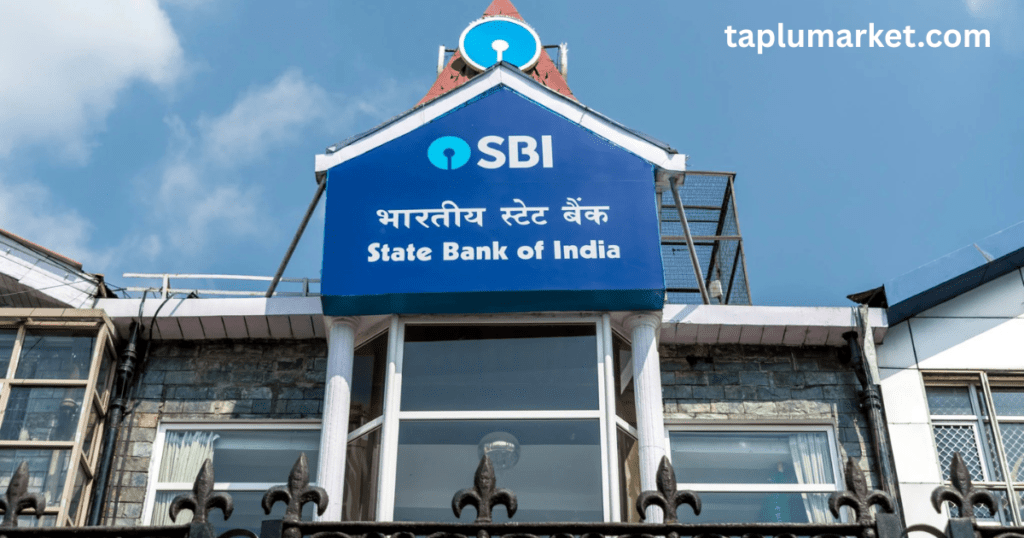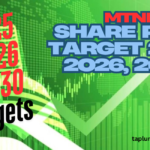The State Bank of India (SBI), the country’s largest public sector bank, holds a dominant position in India’s banking sector with a vast network of over 22,000 branches and a strong digital presence. As a market leader in deposits, loans, and asset size, SBIN (SBI’s stock symbol) is a key player in the Nifty 50 and a favorite among investors for its stability and government backing. But with changing economic conditions, digital banking trends, and interest rate fluctuations, many investors are keen to understand SBIN Share Price Target 2025-2028.

Investors closely track SBIN’s stock performance because of its potential for long-term growth, dividend payouts, and resilience during market volatility. Whether you’re a long-term investor, swing trader, or someone planning to diversify their portfolio, knowing SBI’s future price projections can help in making data-driven investment decisions. This article provides a detailed, research-backed analysis of SBIN’s share price forecast from 2025 to 2028, covering key growth drivers, risks, and expert insights to help you strategize your investments wisely.
Historical Performance of SBIN Shares (2019-2024)
Understanding SBIN’s past stock performance is crucial for predicting its future trajectory. Over the last five years, State Bank of India (SBIN) shares have witnessed significant fluctuations influenced by economic cycles, banking sector reforms, and global market trends. Here’s a breakdown of key milestones and factors that shaped SBIN’s price movement:
Key Milestones in SBIN’s Stock Performance (2019-2024)
- 2019-2020: SBIN traded in the range of ₹250-350, impacted by NBFC crisis, liquidity concerns, and rising NPAs in the banking sector.
- 2020-2021 (COVID-19 Crash & Recovery):
- The stock plunged to ₹150-180 during the March 2020 market crash.
- A strong rebound followed due to government stimulus, moratorium relief, and RBI’s liquidity measures, pushing SBIN back to ₹300-350 by late 2020.
- 2021-2022 (Bull Run):
- SBIN surged past ₹500 as economic recovery, strong credit growth, and digital banking adoption boosted investor confidence.
- The government’s bank privatization buzz also contributed to positive sentiment.
- 2022-2023 (Market Volatility):
- Rising interest rates, global recession fears, and Adani-Hindenburg fallout led to corrections, with SBIN fluctuating between ₹500-600.
- 2023-2024 (Consolidation & Growth):
- Improved asset quality, declining NPAs, and robust quarterly earnings helped SBIN stabilize in the ₹600-700 range.
- The stock hit a 52-week high of ₹750+ in early 2024, reflecting renewed institutional interest.
How Economic & Banking Sector Trends Impacted SBIN’s Price
- RBI Policy & Interest Rates:
- Rate cuts (2020-2021) boosted lending activity, lifting SBIN’s stock.
- Rate hikes (2022-2023) increased borrowing costs, temporarily pressuring margins.
- NPA & Asset Quality Reforms:
- SBI’s efforts in reducing bad loans (Gross NPA down from ~9% in 2018 to ~3% in 2024) improved investor trust.
- Digital Banking Growth:
- YONO app, UPI dominance, and fintech collaborations enhanced SBI’s valuation as a future-ready bank.
- Government Policies:
- PSU bank consolidation, recapitalization, and infra push played a key role in SBIN’s recovery.
Key Factors Influencing SBIN Share Price (2025-2028)
The future SBIN Share Price Target 2025-2028 will be shaped by a mix of macroeconomic conditions, banking sector trends, company-specific developments, and global influences. Understanding these factors can help investors make informed decisions about SBI’s stock performance in the coming years.
Read More:– Cyient Share Price

1. Macroeconomic Factors
India’s economic health plays a pivotal role in determining SBIN’s share price trajectory. Key indicators to watch include:
- GDP Growth: A strong GDP expansion (projected 6-7% annually) could boost credit demand, benefiting SBI’s loan book.
- Interest Rates: RBI’s monetary policy directly impacts SBIN’s profitability.
- Rate cuts = Cheaper loans → Higher borrowing → Better stock performance.
- Rate hikes = Increased cost of funds → Margin pressure → Potential stock dip.
- Inflation & Fiscal Deficit: High inflation may lead to tighter RBI policies, while fiscal stability supports PSU banks like SBI.
2. Banking Sector Trends
The banking industry’s evolution will significantly influence SBIN Share Price Target 2025-2028:
- Digital Banking Revolution:
- SBI’s YONO app, UPI dominance, and AI-driven services will enhance customer reach and efficiency.
- Competition with fintech and private banks may pressure margins.
- NPA Management:
- Declining gross NPAs (from ~9% in 2018 to ~3% in 2024) improve investor confidence.
- Any spike in bad loans (due to economic slowdown) could hurt the stock.
- Credit Growth:
- Rising demand for home loans, MSME credit, and corporate lending will drive SBIN’s revenue.
3. Company-Specific Factors
SBI’s internal strategies and financial metrics will be crucial for its 2025-2028 stock performance:
- Financial Health:
- Strong deposit base, improving ROE (Return on Equity), and stable CASA ratio (Current Account Savings Account) support valuation.
- Government Policies:
- Being a PSU bank, SBI benefits from government recapitalization and policy support.
- Privatization rumors (if any) could cause short-term volatility.
- Expansion Plans:
- Rural banking penetration, international branches, and fintech partnerships could unlock growth.
4. Global Influences
External factors may also sway SBIN’s share price forecast:
- Geopolitical Risks:
- Global recessions, oil price shocks, or trade wars could impact India’s economy and banking stocks.
- FDI in Indian Banking:
- Increased foreign investment in Indian banks may boost liquidity and valuations.
- US Fed Policy & Dollar Strength:
- A strong dollar could lead to FII outflows, pressuring SBIN’s stock temporarily.
SBIN Share Price Target 2025-2028: Detailed Year-wise Forecast
Read More:– ACC Share Price Target
To help investors plan their strategy, we break down SBIN Share Price Target 2025-2028 using analyst projections, technical trends, and fundamental drivers.
SBIN Share Price Target 2025
Bullish vs. Bearish Scenarios
| Scenario | Price Target (₹) | Key Triggers |
|---|---|---|
| Bullish | 750 – 850 | – Strong GDP growth (7%+) – Rate cuts by RBI – Higher credit demand |
| Base Case | 650 – 750 | – Stable economic recovery – Moderate NPA levels |
| Bearish | 550 – 650 | – Global recession fears – Rising inflation & rate hikes |
Technical & Fundamental Outlook
- Technical Analysis:
- If SBIN holds ₹600 support, it may rally towards ₹800.
- Break below ₹550 could signal a downtrend.
- Fundamental Analysis:
- ROE improvement (12%+) and CASA ratio (~45%) are positive signs.
- Valuation: Trading at ~1.2x P/B (Price-to-Book), attractive for long-term.
SBIN Share Price Target 2026
Expected Growth Drivers
✅ Loan Book Expansion – Rising demand in retail/MSME loans.
✅ Digital Adoption – YONO app, UPI transactions boosting fee income.
✅ Declining NPAs – Expected to remain below 3%, improving profitability.
Potential Risks
⚠️ Competition from Private Banks (HDFC, ICICI) may pressure margins.
⚠️ Regulatory Changes – Stricter RBI norms on provisioning.
Price Projection for 2026
| Optimistic | Moderate | Pessimistic |
|---|---|---|
| ₹900 – 1,000 | ₹750 – 900 | ₹600 – 750 |
SBIN Share Price Target 2027-2028
Long-Term Growth Potential
🚀 Market Dominance – SBI controls ~23% of India’s banking assets.
🚀 Government Support – Recapitalization & policy benefits for PSU banks.
🚀 Rural & International Expansion – Untapped markets driving growth.
Possible Challenges
⚠️ Economic Slowdown – If GDP dips below 5%, credit growth may suffer.
⚠️ Global Banking Crises – Liquidity shocks from US/EU recessions.
2027-2028 Price Forecast
| Year | Bullish Target (₹) | Bearish Target (₹) |
|---|---|---|
| 2027 | 1,000 – 1,200 | 700 – 900 |
| 2028 | 1,200 – 1,500 | 800 – 1,000 |
Summary Table: SBIN Share Price Targets (2025-2028)
| Year | Bullish Target (₹) | Bearish Target (₹) | Key Influencing Factors |
|---|---|---|---|
| 2025 | 750 – 850 | 550 – 650 | RBI rates, NPAs, GDP growth |
| 2026 | 900 – 1,000 | 600 – 750 | Digital banking, loan growth |
| 2027 | 1,000 – 1,200 | 700 – 900 | Govt policies, global risks |
| 2028 | 1,200 – 1,500 | 800 – 1,000 | Market share, economic stability |
Expert Opinions & Analyst Predictions for SBIN (2025-2028)
Read More:– ACC Share Price Target

1. Consensus from Top Brokerages
Leading financial institutions have mixed but largely optimistic views on SBIN’s share price target for 2025-2028:
| Brokerage Firm | Rating | Price Target (₹) | Key Insights |
|---|---|---|---|
| Motilal Oswal | Buy | 850 (2025), 1,100 (2026) | “SBI’s digital push & declining NPAs make it a strong long-term bet.” |
| ICICI Securities | Hold | 750 (2025), 950 (2026) | “Valuations fair; growth depends on interest rate trends.” |
| JP Morgan | Overweight | 900 (2025), 1,200 (2027) | “Best-placed PSU bank to benefit from India’s economic growth.” |
| Goldman Sachs | Neutral | 700 (2025) | “Competition from private banks may limit upside.” |
2. Institutional Investor Sentiment
- FIIs (Foreign Institutional Investors): Increasing stake (from ~9% in 2022 to ~12% in 2024) signals confidence.
- DIIs (Domestic Institutional Investors): Steady holdings (~35%) due to SBI’s dividend yield (~2.5%) and stability.
- Retail Investors: Growing interest due to affordable PSU stock status.
Should You Invest in SBIN for the Long Term? (2025-2028)
Pros ✅
✔ Strong Fundamentals:
- India’s largest bank with ₹50+ lakh crore balance sheet.
- Consistent CASA ratio (~45%) ensures low-cost funds.
✔ Trusted Brand + Government Backing: - Minimal risk of collapse (being a PSU).
- Benefits from schemes like PM SVANidhi, Mudra loans.
✔ Dividend Payouts: - Reliable 2-3% dividend yield attracts income investors.
Cons ❌
⚠ High Competition:
- Private banks (HDFC, ICICI) offer better tech & efficiency.
⚠ NPA Risks: - Though improved, agricultural/MSME loans could spike NPAs in a downturn.
⚠ Interest Rate Sensitivity: - RBI rate hikes directly impact profitability.
Final Verdict: Buy, Hold, or Sell?
| Investor Profile | Recommendation | Reason |
|---|---|---|
| Long-Term (5+ yrs) | BUY | SBI’s dominance, digital growth & economic tailwinds justify accumulation. |
| Medium-Term (2-3 yrs) | HOLD | Wait for clearer rate-cut signals from RBI. |
| Short-Term Traders | SELL on rallies | Better momentum plays exist in private banks. |
Conclusion: SBIN Share Price Target 2025-2028
✅ 2025-2026 Outlook:
- Short-term price range: ₹600-850, driven by RBI policies, NPAs, and credit growth.
- Watch for digital banking expansion and quarterly earnings.
✅ 2027-2028 Potential:
- Long-term target: ₹1,000-1,500, if economic growth and reforms continue.
- Risks include global slowdowns and rising competition.
✅ Investment Verdict:
- Long-term investors: BUY on dips (₹600-650).
- Traders: Monitor RBI policies for entry/exit points.
FAQs
1. What is the target price of SBI share in 2025?
Analysts project SBIN’s share price target for 2025 between ₹650-850, with bullish estimates reaching ₹900+ if economic conditions improve.
2. What will be the SBI share price in 2030?
Long-term forecasts suggest ₹1,500-2,000+ by 2030, assuming strong GDP growth, digital banking expansion, and stable NPAs.
3. What is the future prediction of SBIN?
- 2025-2026: ₹700-1,000 (moderate growth)
- 2027-2030: ₹1,200-2,000 (if reforms & economy support banking sector)
4. Is SBI good for long term?
Yes, for investors seeking stable dividends & moderate growth. Risks include competition and rate hikes, but SBI’s government backing makes it a relatively safe bet.
5. Which bank share is best to buy?
- PSU Banks: SBI (safest), Bank of Baroda
- Private Banks: HDFC Bank, ICICI Bank (higher growth potential)
- Best Pick? Depends on risk appetite—SBI for stability, HDFC for aggressive growth.
Disclaimer:
The advice or opinions given on Taplumarket are the personal views of the expert; the brokerage firm, the website or management is not responsible for it. Before investing, please have a look at your financial advisor or certified expert.






